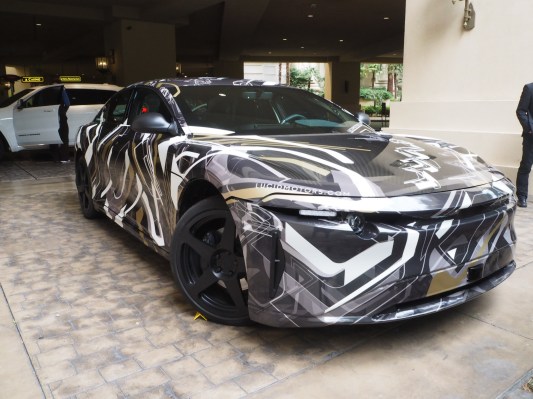Lucid Motors brought its alpha prototype of its first production luxury EV to CES 2017. There’s a small fleet of these early test cars, but the one that made it to Las Vegas is the one in full camouflage. “We wanted it to be like the dazzle ships in World War I,” said Lucid CTO Peter Rawlinson. Then he pointed out that the camo is actually the word Lucid exploded across the side of the car.
Lucid sets itself apart from its competitors in a couple of ways. It began in 2007 as a battery technology company, which is how it raised Series A funding. Then it expanded to encompass electric drivetrains and raised Series B funding in 2011. Then in 2014, it received Series C funding to create a luxury EV.
The result is a vehicle that has been designed from the ground-up to maximize the space that an electric powertrain allows. It has the same exterior size, roughly, as a Mercedes E-class, while inside it’s more like an S-class with a long wheelbase, Rawlinson said. During the test drive, a six-foot-six man sat in the back seat with loads of space to spare.
Thanks to Lucid’s development history, the car will have a 300-mile range, with the option to up that to around 400 miles. The key, Rawlinson said, was Lucid’s breakthrough technology that allows the batteries to be repeatedly charged at high-powered fast chargers and not degrade as quickly as competitors’ systems.
Speaking of competitors, Rawlinson was clear on who the company was targeting, and it’s not Tesla. Lucid has Audi, BMW, and Mercedes-Benz in its sights. “The business model works for luxury vehicles,” Rawlinson said. “Our first product will define us and define the brand.”
Part of that definition is 1000 hp from two motors, front and back, and an expected 0-60 mph time around 2.5 seconds. Rawlinson whipped around the back streets of Las Vegas, chirping tires with the torque and racing to the stop signs before hitting the brakes. There was power to spare and track-worthy handling, though the interior was as bare-bones as it could be.
Lucid will build the vehicles in Arizona and launch in the US, but it will quickly expand to Asian and then European markets. The car will meet all safety and legislative requirements around the world, Rawlinson said, meaning the company only has to build one car for the global market.
The prototype is 90-95% ready for production. One of the hangups that is causing heated debate at Lucid HQ, according to design VP Derek Jenkins, is the charging standard. Do they use SAE, CHAdeMO,or a proprietary system a la Tesla? Or a combination? Or include one standard as standard equipment with the option to choose another?
“A lot of companies are exploring the potential of EVs, but not a lot are successful,” Rawlinson said. “They totally underestimate the enormity of this task.” He acknowledges that Tesla has made starting a car company look easy, but he has confidence that with Lucid’s history and team of experts, as well as the agreement to manufacture in Casa Grande, AZ, that the first cars will be ready for consumers in 2019.
